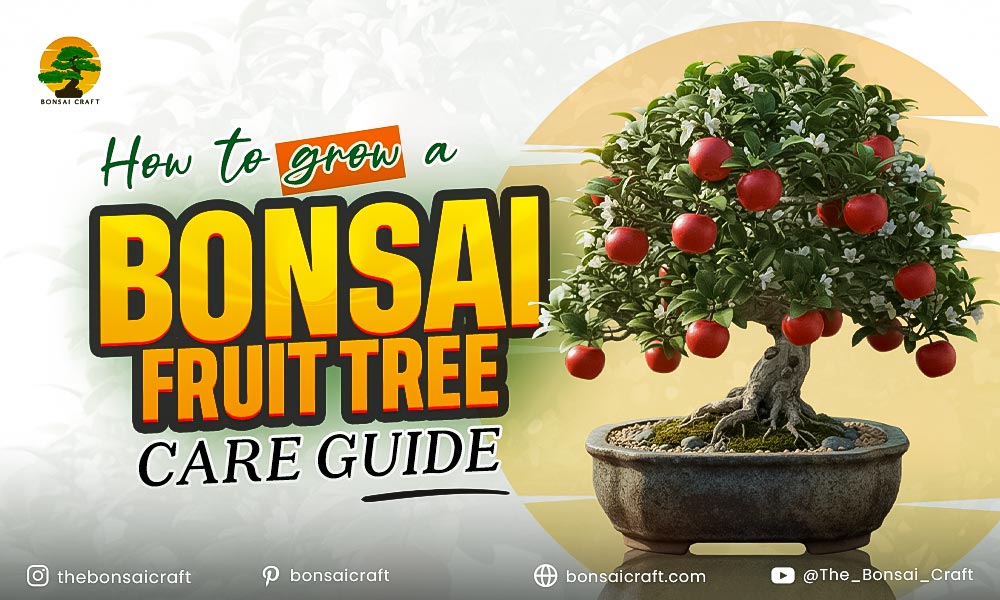
Growing a bonsai fruit tree from seed is one of the most rewarding experiences for plant lovers and bonsai enthusiasts. Unlike buying a pre-grown sapling, starting from bonsai fruit tree seeds allows you to nurture your tree from its earliest stage, shaping it into a miniature masterpiece that bears real fruit.
As someone who has worked with bonsai tree fruit species for years, I can confirm that this practice requires patience, skill, and consistency—but the results are worth it. Whether you dream of a mango bonsai fruit tree, a citrus dwarf bonsai, or even a banana bonsai fruit tree, growing from seed will give you a deeper connection to your plant.
This guide will walk you through the complete process of how to grow a bonsai fruit tree from seed, step by step, while also answering common questions about care, pruning, soil, watering, and fruiting.
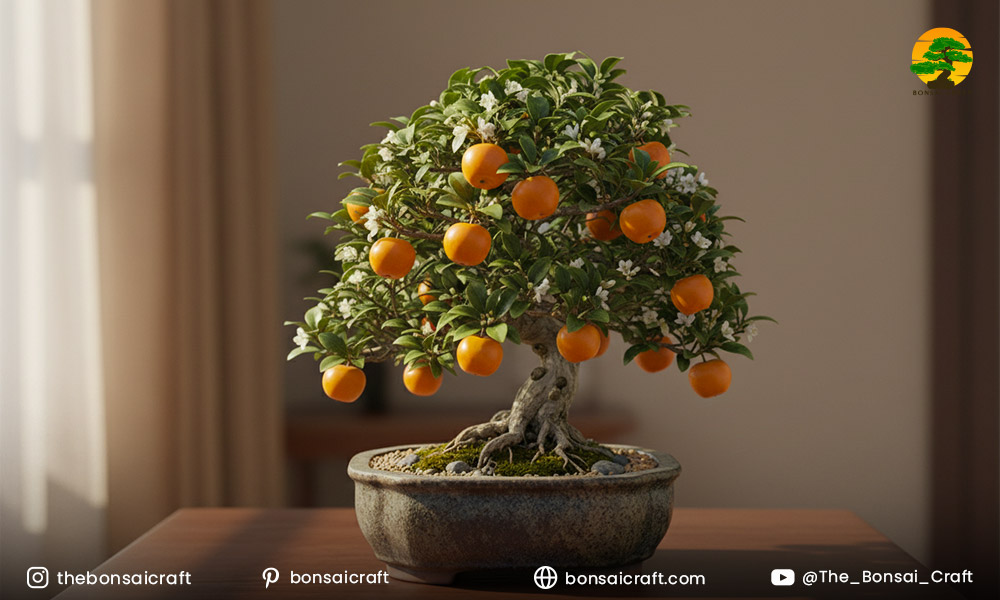
What is a Bonsai Fruit Tree?
A bonsai fruit tree is a miniature version of a full-sized fruit tree, carefully cultivated to stay small while still producing flowers and edible fruits. By using specialized pruning, wiring, and potting techniques, bonsai growers can train fruit tree bonsai varieties such as apple, citrus, pomegranate, persimmon, fig, and mango into beautiful small-scale trees.
Unlike ornamental bonsai, a fruit bonsai tree provides the dual beauty of artistic form and seasonal harvests, making it highly desirable among bonsai enthusiasts.
Can You Bonsai a Fruit Tree?
Yes, you can bonsai almost any fruit tree. With proper training, pruning, and care, fruit trees can be grown in containers as bonsai while maintaining their ability to produce flowers and fruits.
The key factors for success are:
- Choosing the right bonsai fruit tree seeds
- Providing adequate sunlight and watering
- Using well-draining soil
- Regular pruning and repotting
- Patience, since fruit production takes time
Commonly grown fruit bonsai tree species include citrus, figs, persimmons, apples, cherries, and pomegranates.
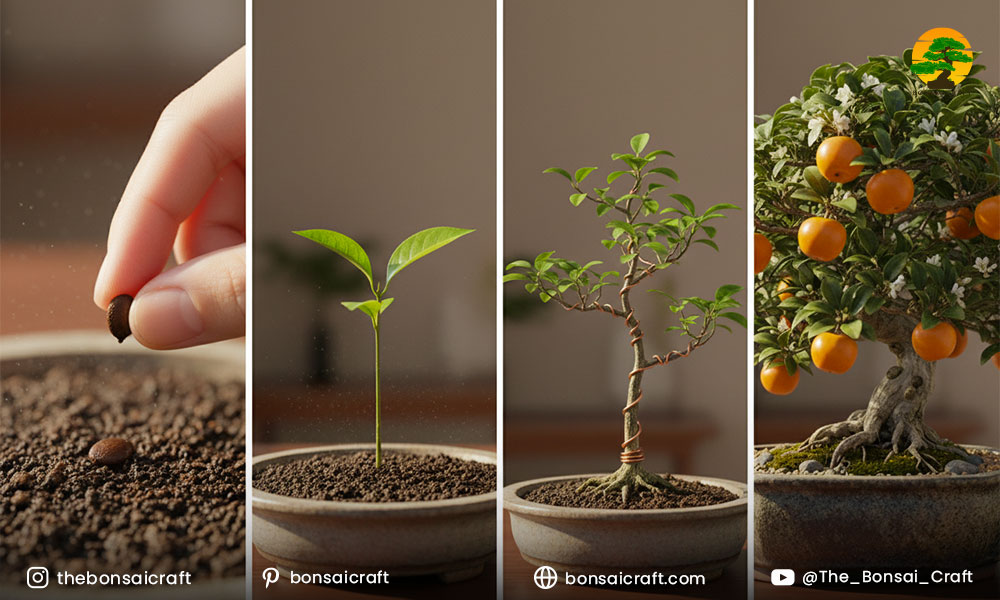
How to Grow a Bonsai Fruit Tree from Seed (Step-by-Step Guide)
Step 1: Select the Right Fruit Tree Species
Not all fruit trees are ideal for bonsai. Look for species with:
- Small leaves and small fruit
- Good regenerative abilities after pruning
- Ability to thrive in pots
Popular options include:
- Japanese persimmon
- Pomegranate
- Lemon or Orange citrus bonsai
- Fig bonsai
- Cherry bonsai
- Mango bonsai fruit tree
Step 2: Prepare Bonsai Fruit Tree Seeds
- Collect fresh seeds from fruits or purchase bonsai fruit tree seeds online.
- Stratify (cold-treat) seeds of temperate fruits like apple, cherry, and persimmon in the refrigerator for 6–8 weeks.
- Tropical fruits like mango and banana usually do not require stratification.
Step 3: Germination
- Plant seeds in a seed-starting tray or small pots with well-draining soil.
- Keep soil moist but not soggy.
- Place in a warm, bright environment.
- Germination may take weeks to months, depending on the species.
Step 4: Seedling Stage
Once seedlings appear:
- Provide bright indirect sunlight.
- Thin out weaker seedlings.
- Begin light fertilization after 6 weeks.
Step 5: First Training (1–2 Years)
- After the seedling reaches 4–6 inches, transfer it to a shallow bonsai pot.
- Begin gentle root pruning to encourage fibrous roots.
- Start shaping the trunk with bonsai wire.
Step 6: Developing Bonsai Structure (3–5 Years)
- Perform structural pruning during late winter or early spring.
- Regularly pinch back new shoots to control growth.
- Repot every 2–3 years to refresh soil and trim roots.
Step 7: Fruit Production (5+ Years)
- With patience, your fruit bonsai tree may begin flowering and fruiting after 5–10 years.
- Provide high-quality fertilizer to support fruiting.
- Thin excess fruit to prevent stress on the tree.
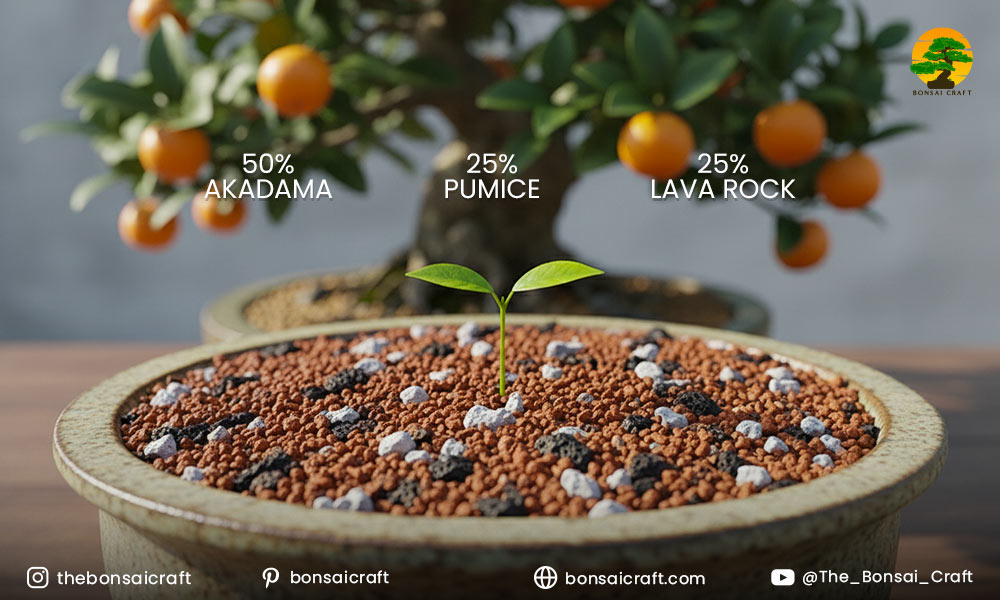
Best Soil for Bonsai Fruit Trees
The ideal soil for a bonsai fruit tree is well-draining while retaining enough moisture for fruit development. A standard bonsai soil mix includes:
- 50% akadama (clay granules)
- 25% pumice
- 25% lava rock
For tropical species like banana bonsai fruit tree, adding organic matter such as compost or coco peat helps maintain moisture.
How to Care for a Bonsai Fruit Tree
Watering
- Water when the top 1 inch of soil feels dry.
- Avoid waterlogging, as fruit trees are prone to root rot.
- Increase watering frequency in summer or during fruiting season.
Fertilization
- Use a balanced fertilizer (NPK 10-10-10) during the growing season.
- Switch to a phosphorus-rich fertilizer when encouraging flowers and fruits.
Pruning and Wiring
- Perform structural pruning in late winter.
- Pinch back new shoots throughout the year for shape maintenance.
- Use bonsai wire to train branches, but avoid scarring by removing wire after 2–3 months.
Sunlight
- Place outdoors in full sun for at least 6 hours daily.
- Tropical species like mango bonsai fruit tree or banana bonsai fruit tree need warm conditions year-round.
Repotting
- Repot every 2–3 years to refresh soil and trim roots.
- Always repot in early spring before new growth begins.
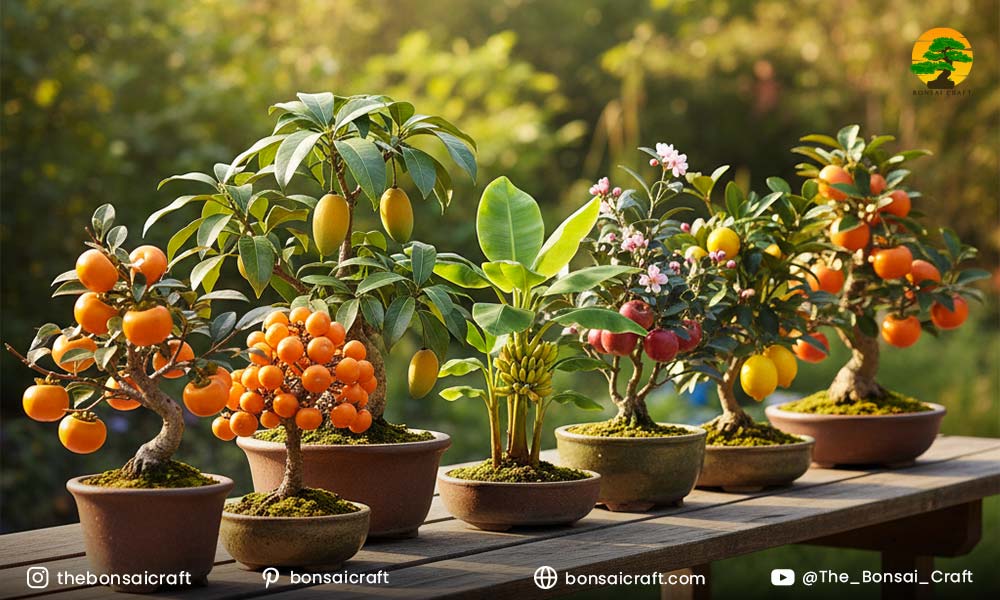
Popular Types of Bonsai Fruit Trees
Japanese Persimmon Bonsai
Known for its stunning orange fruit and elegant structure, the Japanese persimmon bonsai is a favorite among collectors.
Princess Persimmon Bonsai
A miniature version called Princess Persimmon produces small ornamental fruits perfect for bonsai aesthetics.
Mango Bonsai Fruit Tree
A tropical option, the mango bonsai fruit tree grows best in warm climates and can bear small edible mangoes.
Banana Bonsai Fruit Tree
Though more ornamental, the banana bonsai fruit tree is an exotic choice with unique leaves and miniature fruits.
Apple and Citrus Bonsai
Small-leaved apple and citrus varieties are excellent for fruiting bonsai with vibrant blossoms and edible fruits.
Common Problems and Solutions
- Yellow Leaves → Overwatering or poor drainage.
- No Flowers or Fruits → Lack of sunlight or nutrients.
- Pests (aphids, scale, spider mites) → Use neem oil or insecticidal soap.
- Root Rot → Repot in well-draining soil, reduce watering.
Conclusion
Growing a bonsai fruit tree from seed is a journey of patience, care, and artistry. From choosing the right bonsai fruit tree seeds to shaping, pruning, and nurturing fruit production, the process can take years, but the reward of a flowering and fruiting bonsai is unmatched.
As a bonsai enthusiast, my expert tip is this: focus on tree health first, aesthetics second. A strong, healthy tree will naturally evolve into a stunning bonsai with fruits that symbolize resilience and dedication.
FAQs About Bonsai Fruit Tree Care
Can you bonsai a fruit tree?
Yes, almost any fruit tree can be grown as a bonsai with proper pruning and care. Popular choices include persimmons, citrus, apples, figs, mangoes, and pomegranates.
How long does it take to grow a bonsai fruit tree from seed?
It typically takes 5–10 years for a bonsai fruit tree to grow from seed to maturity and begin producing fruit. Patience and consistent care are essential.
Do bonsai fruit trees produce edible fruits?
Yes! Bonsai tree fruit is edible, though often smaller than regular fruits. Citrus, apple, fig, and persimmon bonsai can all bear edible fruits.
What is the best fertilizer for bonsai fruit trees?
A balanced fertilizer (10-10-10) should be applied during the growing season, and a phosphorus-rich fertilizer should be used during flowering to promote healthy growth and fruiting.
Can I grow a bonsai fruit tree indoors?
Some dwarf bonsai fruit trees can grow indoors with strong grow lights, humidity control, and proper ventilation, but outdoor conditions are generally better for fruiting.
